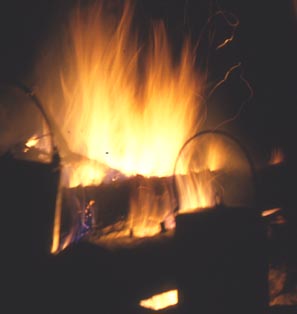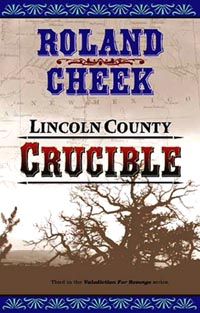We're tired of snow and cold. That's why, after this, there will be no new Campfire Cultures until April 28. Perhaps we will, at that time, regal you with tales of rock art and Anasazi ruins.
CULTURE
WHERE -
TALES ARE TOLD OF
Welcome to Roland Cheek's Weblog
Roland is a gifted writer with a knack for clarifying reality. Looking forward to more of his wisdom
- Carl Hanner e-mail
I've always admired Aldo Leopold's thought processes, as well as his writing. I'm not alone. For reasons I haven't tried to pinpoint, I have the impression the man could never suffer fools gracefully. Perhaps the following excerpt from The Sand County Almanac will demonstrate why I believe it true:
"God started this show a good many million years before he had any men for an audience -- a sad waste of both actors and music. It is just barely possible that God himself likes to hear birds sing and see flowers grow."
To access Roland's weblog and column archives
Tip o' the Day
There've been a few times when a fire became more than a mere pleasant accompaniment to outdoors adventure -- Like the time I was alone, bringing out the last of our hunting camp on the first day of December. The temperature hovered below zero, and two feet of snow lay across the frozen land. And I lost a mitten.
It was while my packstring trundled silently along the trail. I took the mitten off to dig in my saddlebag for a sandwich. After I'd eaten the sandwich, and wished to slide my already freezing fingers into the fur-lined glove, I missed it! My first thought was to stop the packstring and flounder back to look for it. But there were eight laden packhorses back there and I had no idea how long it'd been gone. Besides, it would certainly have been buried in the snow by churning horse hoofs. Later, though, a quickly kindled fire from dead fir limbs broken from trees near the trail saved deadened fingers.
Another time a friend and I returned to road's end after backpacking all day in a drenching rain. We reached a three-sided Forest Service shelter well after dark, scrounged what poor wood we could find with a flashlight, then huddled around a fluttering fire that seemed as if it'd never take off. Then I remembered the battered piece of magnesium wedge (used by tree cutters to tip a tree in a desired direction). An old sawyer had told me they sometimes used battered pieces of old wedges to make warming fires burn hot.
Dumb me! I threw the piece of magnesium (not even as large as a man's billforld) into our fitful fire, then promptly forgot about it while I tried to boil coffee, water for soup, heat campwater for rinsing hands and dishes.
For the uninitiated, magnesium is one of the most difficult metals to weld because its melting temperature and its flashpoint is so close together -- in the neighborhood of 500 degrees. Apparently, some point at the bottom of our little fire, the temperature hovered at 500 degrees.
My friend and I had piled wet wood all around our campfire in hopes it would dry sufficiently to allow us to cook breakfast the following morning. Meanwhile, our coffee water and our soup water and our dishwater barely simmered. Then the magnesium caught!
Instantly the temperature of our fire shot to 2,000 degrees! Flames leaped toward the shelter's shingled roof! Instantly our coffee pot boiled over, the soup pan boiled dry and melted, Luckily I managed to kick the dishpan out into the drumming rain. The wet wood we had scattered around the fire instantly steam-dried, began smoldering, then turned to blaze! My friend and I threw coats over our faces and tried to push the wood out into the rain with long sticks. For a moment we thought we'd lose the building.
Then the magnesium chunk burned out and the flames receded to lick merrily at the charred firewood left in the firepit. Sheepishly we gathered our scattered wood, now all dry, and ricked it along one wall. Then we started cooking all over again.
No, Roland Cheek hasn't been in a gunfight at the O.K. Corral or punched dogies down the streets of Abilene. But he has straddled rawboned ponies over 35 thousand miles of the toughest trails in all the Northern Rockies and spent five decades wandering the wild country throughout the West. Now, after crafting six prior nonfiction books, hundreds of magazine articles, and thousands of newspaper columns and radio scripts about his adventures, the guy has at last turned his talent to Western novels, tales from the heart, dripping with realism, and based in part on a plethora of his own experiences.
* * *
BIG TICK MEDICINE
Ticks, according to research, feed only a few times in their lives. That's why they make the most of it when they find a warm body. Spring is the worst time of year for tick attacks. I suppose it's because they're hungry after a long winter.
Don't depend on the spring thing, though. Two of my hiking companions picked up ticks while eating lunch on a snow-covered hillside this past february, and I've wrestled with one or two of the feisty devils in August.
Ticks instinctively ascend whatever they land upon. If the thing they've landed upon does not provide a satisfactory meal, they climb until they find another satisfactory launch spot, then wait until a warm body chances along to brush against them. Once aboard the warm body, they climb until they find a moist area: armpits, crotch, ear, or sometimes amid sweaty hair.
It usually takes a tick half a day to crawl to his tasty attack point and set up shop. This is why a person can usually avoid tick discomfort by checking themselves over thoroughly twice each day. Jane and I use the "buddy system" for tick checking and removal. I like the system. Jane only accepts it as a "necessary evil."
A tick attack begins with the creature boring in and establishing a lining around the hole. Then he exchanges saliva for blood. It's in the saliva-transfer where lyme disease or Rocky Mountain Spotted Fever is most often transmitted.
Most ticks, of course, do not carry disease. And even if you have the misfortune to be attacked by one that does, symptoms are recognizable and need not be serious if treated promptly. Symptoms include headache, muscle ache, rash, and perhaps high temperature.
Many suggested treatments for tick attacks include "old wives tales," like the one about screwing ticks out clockwise (or counter-clockwise, I forget), or burning them out with a cigarette stub or a flaming match head, a method I tried once--but only once! Most treatments recommend not pulling the boogers strait out because you'll break off their heads. Some recommended treatments also says to save the carcass for later identification by the medical profession. The advisory I'm looking at as I write this column says to place the tick in a vial and add a little moisture to keep the devil alive.
I disagree. I dispatch each tick who has the audacity to attach their esophagus to my armpit. I do so by cutting them in half, fingernail against thumbnail with the tiny demon stuck between pressure points. I also disagree with some of the same advisory's idea of prevention: "Build a barrier against the tick," they say. The way to do this, they continue is to "wear long pants and tuck them into your socks."
They also tell you to wear light-colored clothing so you can more easily spot a tick (true, but a ridiculous idea for a man packing horses into the backcountry--the pour soul would be a laughingstock within ten minutes of rubbing against sweaty horses and handling muddy packs).
Despite the advice, I much prefer shorts while hiking. I choose shorts because the doing so enables me to feel ticks as well as see them.
The final travesty in the printed advisory published by the U.S. government comes when they tell you to "wear slippery outer clothing so the ticks will fall off when they make their leap of faith (presumably from some bush to your body)." Count me out when it comes to wearing a suit of armor up a mountain trail--I'll leave that to actors from Star Wars; Three-Seepio perhaps? Even rubberized rainwear is beyond my ken on a hot summer day.
No, I'll continue to wear comfortable clothing adapted to the elements. With the full mobility afforded by those loose-fitting garments, I'll continue to pull off any froward ticks, dispatch them with dexterous use of fingernails, and continue on my merry, comfortable way.
Roland Cheek wrote a syndicated outdoors column (Wild Trails and Tall Tales) for 21 years. The column was carried in 17 daily and weekly newspapers in two states. In addition, he scripted and broadcast a daily radio show (Trails to Outdoor Adventure) that aired on 75 stations from the Atlantic seaboard to the Pacific Ocean. He's also written upwards of 200 magazine articles and 12 fiction and nonfiction books. For more on Roland, visit:
www.rolandcheek.com
Recent Weblogs
Tuesday, April 7, 2009
for more info about these and other Roland Cheek books
There's a bunch of specific info about Roland's books, columns, archives and radio programs. By clicking on the button to the left, one can see Roland's synopsis of each book, read reviews, and even access the first chapter of each of his titles. With Roland's books, there's no reason to buy a "pig in a poke."
for detailed info about each of Roland's books
Read Reviews
Read their first chapters
For interested educators, this weblog is especially applicable for use in history, outdoor/nature and journalism classes.
Roland, of course, visits schools. For more information on his program alternatives, go to:
SEE YOU APRIL 28!
BE SAFE UNTIL THEN; JANE AND I LOVE YOU ALL!
www.campfireculture.com
Award-winning Western writer Richard Wheeler says of Roland's novels:
Like Louis L'Amour, Roland Cheek knows how to start a story at a gallop and hold the reader to the last page. he writes richly and authentically about the Old West, drawing from an encyclopedic knowledge of his subject.
1st in series
2nd in series
3rd in series
4th in series
5th in series
6th in series
to send this weblog to a friend
to tell Roland what you think of his Campfire Culture weblog
to visit Roland's newspaper columns and weblog archives
source links for additional info








